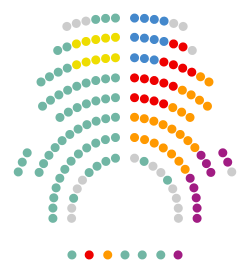Parliament of Catalonia
| Parliament of Catalonia Parlament de Catalunya | |
|---|---|
| 11th Legislature | |
 | |
| Type | |
| Type | |
| History | |
| Founded | 1932 |
| Leadership | |
| Structure | |
| Seats | 135 |
 | |
Political groups |
Government (62):
Confidence and supply (10):
Opposition (63): |
| Committees |
22
|
| Elections | |
| Party-list proportional representation | |
Last election | September 27, 2015 |
Next election | On or before November 11, 2019 |
| Meeting place | |
|
| |
| Palau del Parlament de Catalunya, Parc de la Ciutadella, Barcelona, Catalonia, Spain | |
| Website | |
| www.parlament.cat | |
 |
| This article is part of a series on the politics and government of Catalonia |
|
Statute |
|
Judiciary
|
|
Public order |
|
Divisions
|
The Parliament of Catalonia (Catalan: Parlament de Catalunya, IPA: [pərɫəˈmen də kətəˈɫuɲə]) is the unicameral legislature of Catalonia (autonomous community of Spain). It is formed by 135 members ("diputats"), who are elected every four years or after extraordinary dissolution, chosen by universal suffrage in lists with four constituencies, the Catalan provinces. The Parliament building is located in Ciutadella park, Barcelona.
The most recent parliamentary elections were held on 27 September 2015.
History
Catalan Courts
The first representative and legislative bodies in Catalonia were the Peace and Truce of God Assemblies (assemblees de pau i treva), of which the earliest record dates from 1027. These were originally ad hoc, local meetings convened by the Church (Oliba, Bishop of Vic, who died in 1046, was a notable instigator) but progressively became subsumed into the court of the Counts of Barcelona. The first Catalan legal code, the Usatges de Barcelona, was promulgated by Count Ramon Berenguer I based on the decisions of these assemblies.
Although the Counts of Barcelona, also Kings of Aragon from 1137, had greatly extended the territory under their control, their financial and military power was quite limited, partly because of their former status as vassals of the Carolingian dynasty. Their personal resources were particularly insufficient in periods of economic crisis or military expansion, of which they were many from the twelfth to the fifteenth centuries. The need to secure troops and revenue led to the steady expansion of the royal court and a formalisation of its procedures. It came to be referred to as the Cort General de Catalunya or Corts catalanes (Catalan Courts), and was endowed with formal procedures, effectively a written constitution, by King Peter III of Aragon in 1283, making from this institution the policemaking and legislative body of the Principality of Catalonia.
The Corts Catalanes were composed of Three Estates (Tres Braços), representing the Church, the feudal nobles and the citizens of Royal towns such as Barcelona or Girona. Inhabitants of feudal towns (such as Cardona) were not represented, except by their overlords. The main function of the Corts was legislative, either in approving laws proposed by the King (Constitucions) or at their own initiative (capítols de cort). Although the Corts met at irregular intervals (as often as the Crown needed to find new resources), it also formally approved the acts of the King between their sessions (known as pragmàtiques) and, from 1359, established a permanent delegation to oversee the Crown (the Deputation of the General, forerunner of the Generalitat de Catalunya). The Catalan Courts were abolished by the Nueva Planta decrees in 1716 after Catalonia's defeat in the War of the Spanish Succession.
Modern history
There were several attempts in the early 20th century to institute an autonomous system of representation for Catalonia. The Commonwealth of Catalonia (1914–25) was an assembly without legislative powers of the provincial delegations of Barcelona, Girona, Lleida and Tarragona, abolished by the Spanish dictator Miguel Primo de Rivera in 1925.
After an abortive declaration of the Catalan Republic in 14 April 1931, a separate Parliament of Catalonia was established under the first Statute of Autonomy approved by the new Spanish Republic, and was elected on 20 November 1932. This legislature of the Parliament, controlled by the Republican Left of Catalonia (the winning party of the Catalan elections) developed an advanced social and democratic legislation in different areas (civil law, culture, health...), but it was suspended between 1934 and 1936, restored in February of this year and abolished by the dictatorship of Francisco Franco in 1938, during the Spanish Civil War. The republican Parliament remains exiled since 1939. After the death of the dictator (1975) and the progressive restoration of democracy, the new Statute of Autonomy of Catalonia of 1979 recognized the restoration of the Parliament. The first legislature of the current Parliament of Catalonia was elected in 20 March 1980.
Functions
- To elect the President of the Generalitat de Catalunya.
- To pass the Catalan legislation in the business of its competence.
- To pass the Budget of the Autonomous Community of Catalonia.
- To control the action of the Government of Catalonia and the autonomous agencies, public companies and all other bodies answerable to it.
References
- "Parlament de Catalunya – Història" (in Catalan). Retrieved January 5, 2007.
External links
- Official website (multilingual, mostly in Catalan)
| Politics of Catalonia | |||||
| Parliament of Catalonia series | |||||
| |||||
Coordinates: 41°23′17″N 2°11′20″E / 41.38806°N 2.18889°E